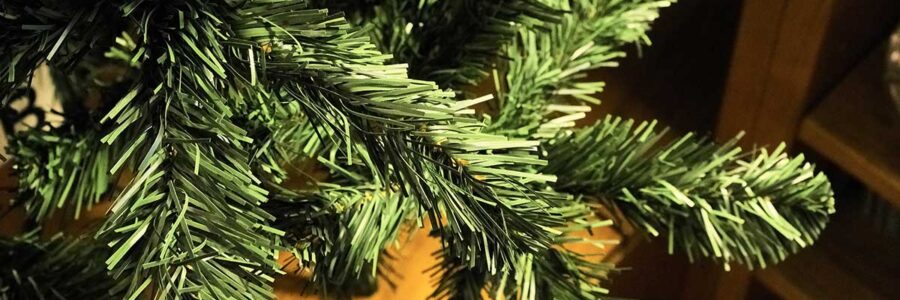The holiday season often involves setting up Christmas trees, and artificial trees have become popular for their ease and durability. However, a hidden concern lies beneath their convenience and beauty: harmful toxins. This guide highlights the potential risks associated with artificial Christmas trees and offers insights into safer alternatives.
The Toxic Components of Artificial Trees
Artificial Christmas trees may contain harmful materials like Polyvinyl Chloride (PVC),[1] lead,[4] and flame retardants.[6] PVC, widely used in these trees, can release phthalates and volatile organic compounds (VOCs) linked to hormonal disruptions and respiratory issues.[2,3] Lead, often added to stabilize PVC, is a toxic metal with significant health risks, especially for children, affecting neurological development.[5] Though added for safety, flame retardants are associated with health risks, including endocrine disruption and impacts on hormonal systems.[6]
Health Risks of Artificial Trees
The VOCs emitted from PVC can cause irritation of the eyes, nose, and throat, lead to headaches, and worsen asthma symptoms.[7] Continuous exposure to these compounds might result in more serious respiratory problems and hormonal imbalances. Lead exposure is particularly concerning, with potential effects like learning disabilities, developmental delays, and behavioral issues in children.[8] Flame retardants can accumulate in the body over time, leading to thyroid issues, fertility problems, and certain cancers.[6]
Safer Alternatives to Traditional Artificial Trees
Some manufacturers have begun producing artificial trees free from PVC, lead, and flame retardants in response to these health risks. These trees are safer, though they may not be completely toxin-free and typically cost more. Their availability is also limited, requiring more effort from consumers to find them.
The Benefits of Natural Christmas Trees
Given the risks associated with artificial trees, many people are turning back to natural Christmas trees. These trees don’t pose the same indoor air pollution risks and add a genuine charm and pine scent to the holiday atmosphere. When choosing natural trees, selecting those from local farms practicing sustainable and organic farming is beneficial, as they use fewer chemicals. Wild trees are also biodegradable, offering an environmentally friendly option after the holiday season.
Making an Informed Choice
Choosing the right Christmas tree involves weighing convenience, aesthetic appeal, and health considerations. If you prefer artificial trees, it’s important to research and choose a safer, toxin-free option. For those leaning towards natural trees, supporting sustainable and organic farms can enhance their benefits. Being well-informed about the potential health impacts on your family and the environment is key to making the best decision.
Summary
The festive season brings joy and celebration, and the Christmas tree is a central symbol of this time. Understanding the potential health implications of artificial Christmas trees is crucial in making a conscious decision. Whether you choose a safer artificial tree or a natural one, an informed decision can lead to a healthier and more environmentally friendly holiday season.
References:
- PVC at a Glance – Noharm-Europe.Org, PVC at a Glance.
- Alford, Kyle L, and Naresh Kumar. “Pulmonary Health Effects of Indoor Volatile Organic Compounds-A Meta-Analysis.” International journal of environmental research and public health vol. 18,4 1578. 7 Feb. 2021, doi:10.3390/ijerph18041578.
- Wang, Yufei, and Haifeng Qian. “Phthalates and Their Impacts on Human Health.” Healthcare (Basel, Switzerland) vol. 9,5 603. 18 May. 2021, doi:10.3390/healthcare9050603.
- “Health Effects of Lead Exposure.” Centers for Disease Control and Prevention, 2 Sept. 2022, CDC – Lead Exposure Health Effects.
- Wani, Ab Latif, et al. “Lead toxicity: a review.” Interdisciplinary toxicology vol. 8,2 (2015): 55-64. doi:10.1515/intox-2015-0009.
- “Flame Retardants.” National Institute of Environmental Health Sciences, U.S. Department of Health and Human Services, NIEHS – Flame Retardants.
- Alford, KyleL, and Naresh Kumar. “Pulmonary Health Effects of Indoor Volatile Organic Compounds-A Meta-Analysis.” International journal of environmental research and public health vol. 18,4 1578. 7 Feb. 2021, doi:10.3390/ijerph18041578.
- Wani, Ab Latif, et al. “Lead toxicity: a review.” Interdisciplinary toxicology vol. 8,2 (2015): 55-64. doi:10.1515/intox-2015-0009.


